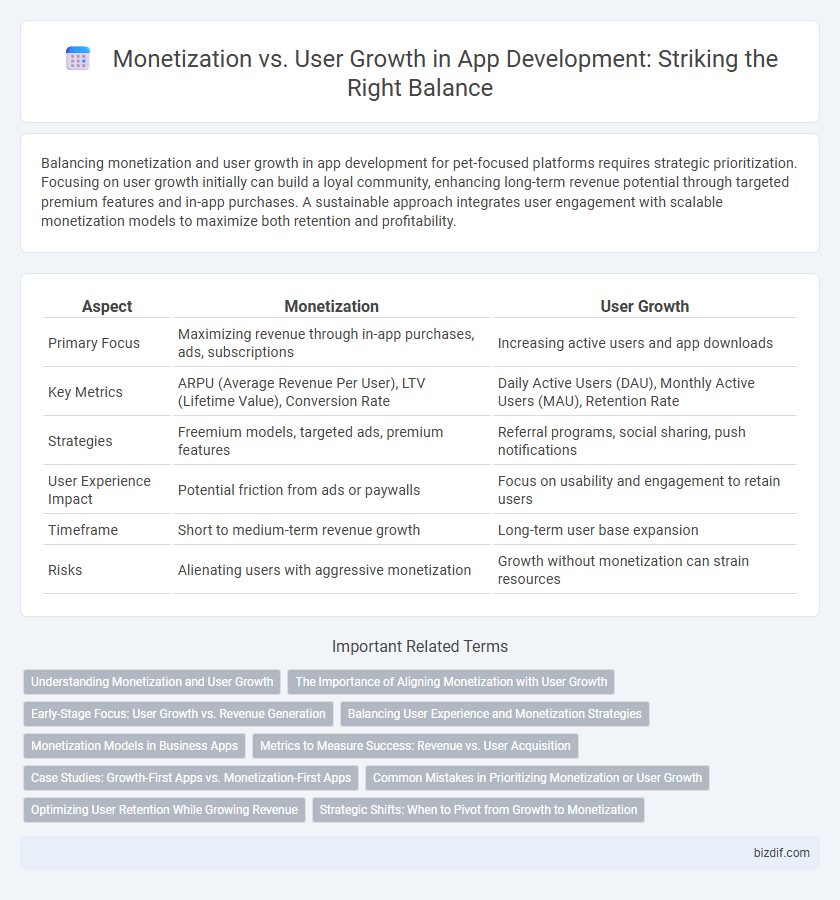Balancing monetization and user growth in app development for pet-focused platforms requires strategic prioritization. Focusing on user growth initially can build a loyal community, enhancing long-term revenue potential through targeted premium features and in-app purchases. A sustainable approach integrates user engagement with scalable monetization models to maximize both retention and profitability.
Table of Comparison
| Aspect | Monetization | User Growth |
|---|---|---|
| Primary Focus | Maximizing revenue through in-app purchases, ads, subscriptions | Increasing active users and app downloads |
| Key Metrics | ARPU (Average Revenue Per User), LTV (Lifetime Value), Conversion Rate | Daily Active Users (DAU), Monthly Active Users (MAU), Retention Rate |
| Strategies | Freemium models, targeted ads, premium features | Referral programs, social sharing, push notifications |
| User Experience Impact | Potential friction from ads or paywalls | Focus on usability and engagement to retain users |
| Timeframe | Short to medium-term revenue growth | Long-term user base expansion |
| Risks | Alienating users with aggressive monetization | Growth without monetization can strain resources |
Understanding Monetization and User Growth
Monetization strategies in app development focus on converting user engagement into revenue through methods like in-app purchases, subscriptions, and advertising, which directly impact the app's profitability. User growth emphasizes expanding the active user base by improving user acquisition, retention, and engagement metrics, crucial for scaling the app's reach and influence. Balancing monetization and user growth requires analyzing data-driven insights to optimize revenue generation without compromising user experience or growth potential.
The Importance of Aligning Monetization with User Growth
Aligning monetization strategies with user growth is critical for sustainable app development success. Prioritizing user experience while integrating monetization models such as in-app purchases, subscriptions, or ads ensures increased user retention and lifetime value. Effective balance between revenue generation and user engagement drives scalable growth and long-term profitability.
Early-Stage Focus: User Growth vs. Revenue Generation
Early-stage app development prioritizes user growth to establish a robust and engaged audience before emphasizing revenue streams. Strategies such as offering free features, optimizing onboarding, and enhancing user experience drive adoption and retention. Monetization efforts typically begin after achieving critical mass, ensuring sustainable long-term growth through targeted revenue models.
Balancing User Experience and Monetization Strategies
Effective app development requires balancing monetization strategies with user growth to ensure sustainable success. Prioritizing seamless user experience while integrating non-intrusive advertising, in-app purchases, or subscription models increases user retention and lifetime value. Data-driven adjustments based on user feedback and behavior analytics optimize both revenue generation and user satisfaction.
Monetization Models in Business Apps
Effective monetization models in business app development include subscription services, in-app purchases, and freemium plans that balance revenue generation with user retention. Subscription models provide a steady income stream by offering tiered access to features, while in-app purchases allow customization and enhanced functionality tailored to user needs. Implementing a freemium approach attracts a broad user base by offering essential features for free and premium upgrades, optimizing both user growth and profitability.
Metrics to Measure Success: Revenue vs. User Acquisition
Measuring success in app development requires balancing revenue generation metrics such as Average Revenue Per User (ARPU) and Lifetime Value (LTV) against user acquisition indicators like Daily Active Users (DAU) and Cost Per Install (CPI). High ARPU coupled with strong LTV indicates effective monetization, while increasing DAU and low CPI signify robust user growth. Optimizing these metrics ensures sustainable app success by aligning monetization strategies with scalable user acquisition efforts.
Case Studies: Growth-First Apps vs. Monetization-First Apps
Growth-first apps like Instagram prioritize rapid user acquisition and engagement, achieving scale before implementing monetization strategies, resulting in expansive user bases that attract diverse revenue opportunities. Monetization-first apps such as Tinder focus on early revenue generation through subscriptions or in-app purchases, which can limit initial growth but sustain development and profitability from the outset. Case studies reveal that growth-first models excel in market penetration, while monetization-first apps maintain stronger early cash flow, highlighting distinct strategic trade-offs in app development.
Common Mistakes in Prioritizing Monetization or User Growth
Focusing solely on monetization often leads to a poor user experience, driving away potential long-term users and limiting organic growth. Conversely, prioritizing user growth without a clear monetization strategy can result in unsustainable financial models and hinder app scalability. Successful app development balances user acquisition with revenue generation to maintain both engagement and profitability.
Optimizing User Retention While Growing Revenue
Maximizing user retention is crucial for sustainable app monetization, as loyal users generate higher lifetime value and increase revenue streams through in-app purchases and subscriptions. Implementing targeted engagement strategies such as personalized notifications, rewards programs, and seamless user experiences enhances retention rates and drives consistent growth. Balancing monetization efforts with user-centric design fosters long-term growth by maintaining active user bases while optimizing revenue generation.
Strategic Shifts: When to Pivot from Growth to Monetization
Strategic shifts from user growth to monetization in app development are critical when market penetration reaches saturation or user acquisition costs exceed returns. Data-driven insights reveal that prioritizing revenue generation after establishing a solid user base maximizes lifetime value and profitability. Timing this pivot effectively hinges on analyzing retention rates, engagement metrics, and competitive landscape to ensure sustainable growth and financial viability.
Monetization vs User growth Infographic

 bizdif.com
bizdif.com